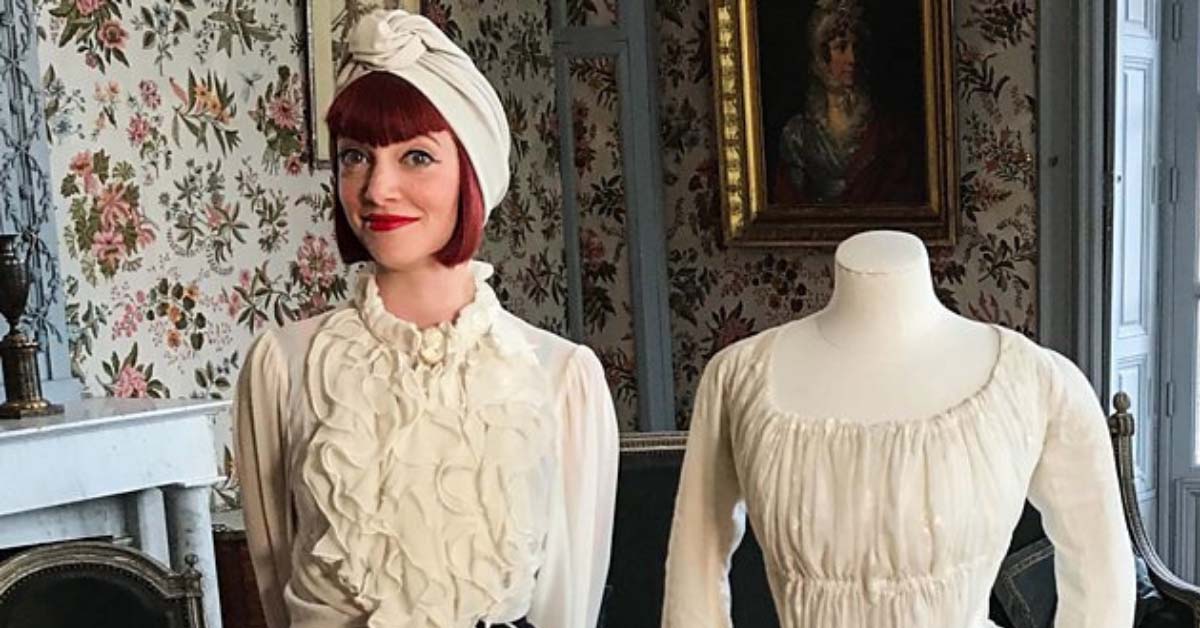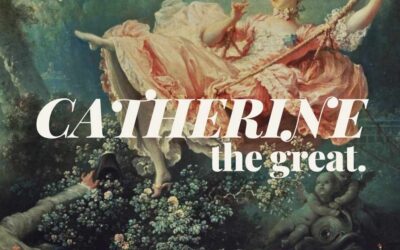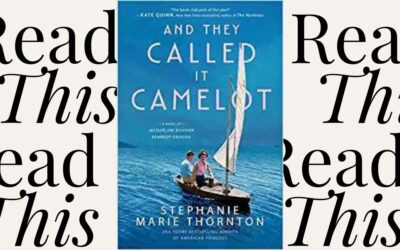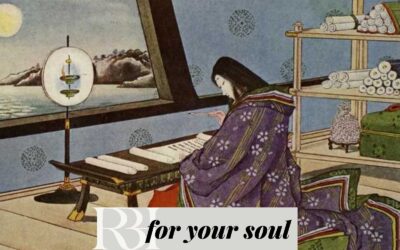We wear clothes every day, and we consciously choose them based on how we want to be perceived.
A date night dress tells a different story than a work suit. Yet, both serve wildly different functions from your lazy Sunday sweatpants.
Fashion historian Amber Butchart is dedicated to exploring what our clothes say about us. Her series with BBC Four, A Stitch in Time (available for US viewers on Amazon Prime), uses art and historical fashion to reveal the secrets of life in bygone eras.
Butchart, author of The Fashion Chronicles: The style stories of history’s best dressed and The Fashion of Film: How Cinema has Inspired Fashion, leads the show as its main host. She partners with renowned historical customer Ninya Mikhaila as they recreate history’s most iconic looks.
It is an intriguing premise. The series succeeds in crafting well-rounded narratives that draw from multiple disciplines, appealing to both art and fashion lovers alike.
As Butchart frequently says, “Clothes are the ultimate form of visual communication.” Her thorough and creative analysis of the depicted garments allow the past to speak to us.
The Research Behind “A Stitch In Time”s Historical Recreations
Most A Stitch in Time episodes begin with a painting.
The first season discusses six separate works of art: Charles II Presented with a Pineapple, The Arnolfini Portrait by Jan van Eyck, The Hedge Cutter, Lady Elizabeth Murray and Dido Belle by David Martin, Edward the Black Prince’s funeral effigy, and La Reine en gaulle by Elisabeth Vigée Le Brun.
Butchart identifies the outfit to recreate, consults with Mikhalia, and they both get to work.
What makes the series fun is that, In most cases, they don’t have an extant garment to reference…only the painting.
One exception is Edward the Black Prince’s military jupon. The original garment still exists- his will stipulated it be hung over his tomb. His will was honored for decades until later preservationists realized environmental damage to the fabric- and packed it away for safekeeping.
When Butchart uncovers the original fourteenth century garment with the curator, it’s nothing short of thrilling.
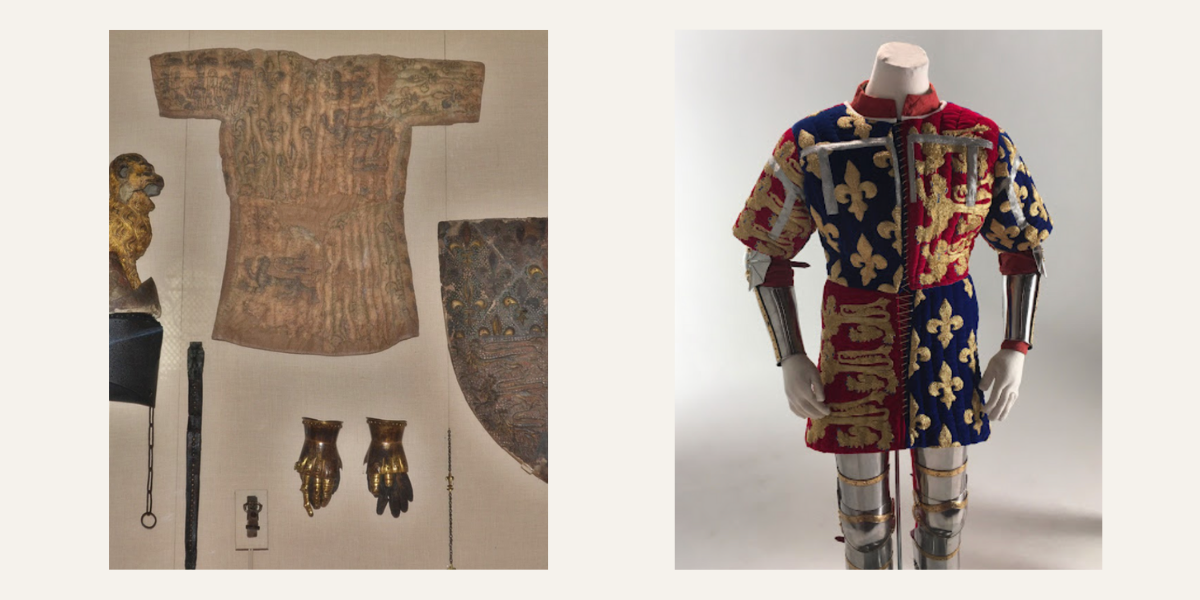
Along the way, Mikhalia and Butchart discover the art and history of a garment. But the duo also dives into the related fields of sewing, finance, textiles, class, gender, and race.
To even begin to craft the garment from a historically accurate perspective, they realize a broader historical context is needed to remain faithful to the recreation. Mikhalia often remarks that the only way to figure out how to reconstruct a historical outfit is to just do it. Otherwise, you simply don’t know the right questions to ask.
Walking In History’s Shoes
Butchart sports signature velvet turbans and immaculately chic outfits. However, she isn’t afraid to go the extra mile to walk in the shoes of centuries passed.
Before trying on the Black Prince’s jupon, she gets into gym clothes to train in period armor. To achieve the vibrant green of The Arnolfini Portrait, Butchart helps create historically-accurate dyes…leveraging stale urine as the key period ingredient.
The research that Butchart and Mikhalia conduct is fascinating, but the highlight of each episode of A Stitch in Time is the ending: The moment when Bukhart tries on the outfit and reflects on how it makes her stand, move, and feel.
When she puts on the Black Prince’s military jupon, she reflects: “As a historian, you are always trying to imagine the past, and imagine it as accurately as you possibly can based on the evidence. I spend a lot of time in museums looking at dress in cabinets and underneath glass, and being able to touch this and feel it and know that it’s the same textures, the same materials that would have been felt in the fourteenth century is really incredible.”
Wearing the Clothes Reveals the Unexpected
Butchart initially dismissed the idea that Dido Belle’s gown might be a fancy dress costume. Although it featured more “exotic” elements, like a loosely wrapped V neckline, turban, and lack of structural undergarments, she observed that attire “à la Turque” was very popular with eighteenth century ladies.
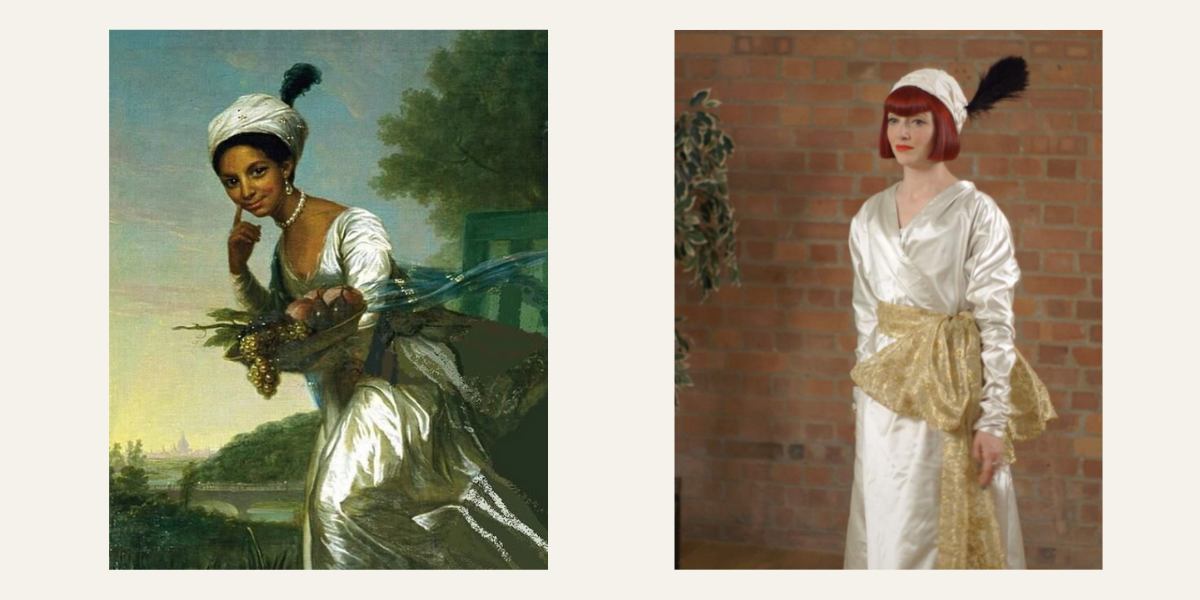
However, when she put on the dress herself, she realized that it doesn’t feel like everyday clothing.
Other garments, such as Charles II’s three-piece suit (the original version of the modern menswear staple) have unexpected affects on her stance and movement, but Dido’s dress truly felt like a costume… not clothing.
Amber highlights how these garments provide a window into history. They show not only what happened but how it felt to live in the time period.
Class Position and Clothing: Sewn Together.
Class affects how a garment looks and feels, but it also affects which garments survive the test of time.
Butchart had the opportunity to view a royal’s extant garment with the Black Prince. For the lower class The Hedge Cutter? She had to undertake extensive detective work to reconstruct the coat.
Class is the dominant theme in half of A Stitch in Time’s episodes. This theme is most prominent in The Arnolfini Portrait, The Hedge Cutter, and La Reine en gaulle.
For example, Butchart is shocked by the intense weight when she puts on the stunning green doe-skin gown from The Arnolfini Portrait. Some have posited that the woman in the picture might be pregnant based on how she clutches her midsection. Butchart refutes the theory wholeheartedly.
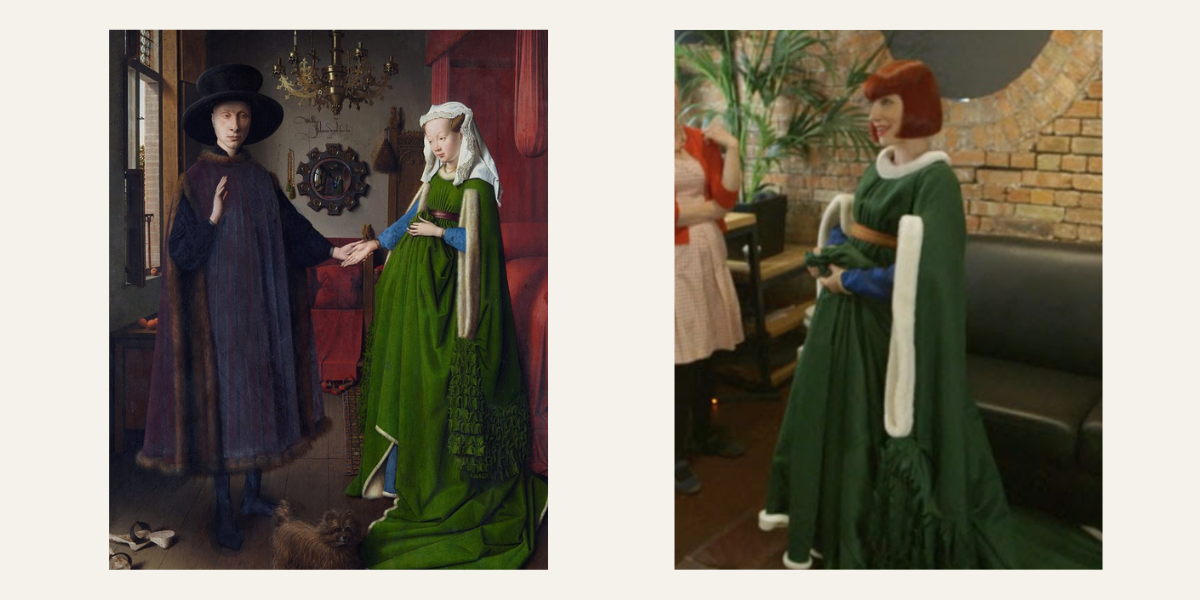
Putting the gown on, she realizes that she has to hold the extra fabric in front of her to simply keep her balance:
“It’s a constant reminder of your wealth. This is so heavy; I’ve got so much money, she remarks, while wearing the dress.
Series Conclusion: La Reine En Gaulle
La Reine en gaulle is A Stitch in Time’s series finale. The episode interweaves the series’ main themes while also presenting a garment that actually changed history.
I had just finished Queen of Fashion: What Marie Antoinette Wore to the Revolution by Caroline Weber before watching this series, and I was thrilled to see Butchart’s discussion.
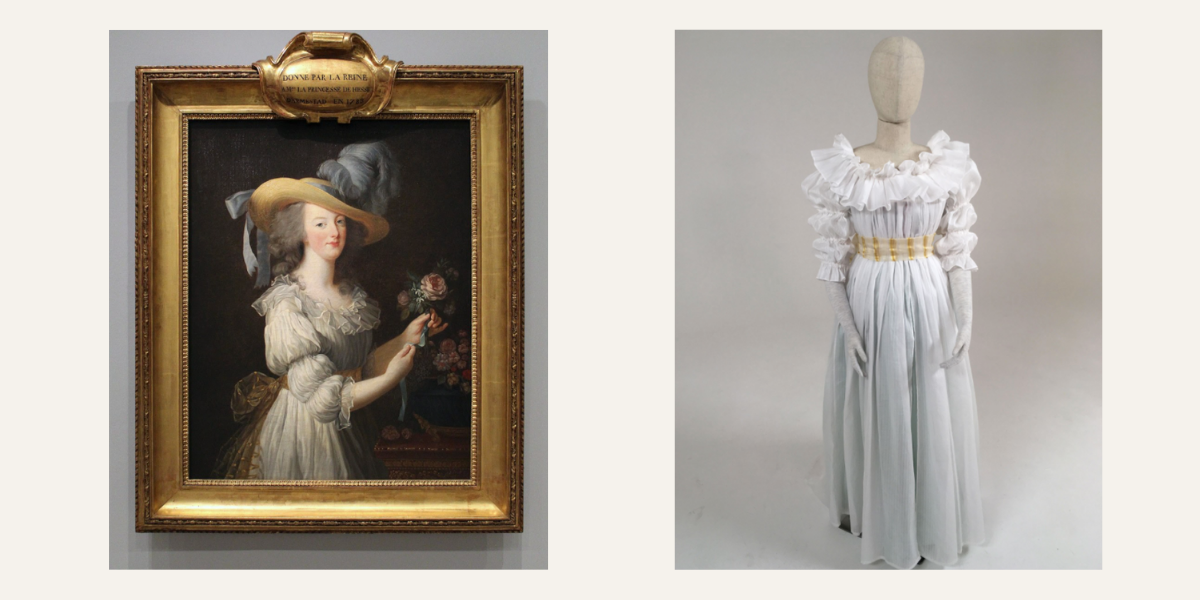
This infamous painting of Marie Antoinette shows the Queen of France in a simple white dress that recalls the chemises worn as undergarments at the time.
The gaulle or chemise à la Reine, as it was also called, was the uniform of Marie Antoinette’s palace at Petit Trianon. She would flee to this estate near Versailles, and its accompanying storybook village, the Hameau de la Reine, to escape the rigors of court life.
Even though the gown appears simple, it still showcases Marie Antoinette’s wealth. The dress’ expensive lightweight muslin fabric required meticulous hand sewing. Plus, keeping a garment white in the eighteenth century before washing machines required arduous, time-consuming labor.
As Butchart describes it, “This is a queen’s idea of how a shepherdess might dress.”
She expects the garment to be easy and loose fitting. Instead, she still feels the structure from her stays. The flounces remind her of a more modern royal icon: Princess Diana’s wedding dress.
Consequences of the Gown
At the Hameau de la Reine, the sheep were perfumed to keep from shattering Marie Antoinette’s dreamworld with unpleasant smells. This dress is a similar fabrication of the imagination. It’s a way to safely pretend she wasn’t royalty without losing any of the privileges of her status.
Still, Marie Antoinette never expected this dress would serve as a catalyst for the loss of her position, her money, and eventually, her life. The painting caused such a scandal that it had to be removed from the 1783 exposition. It was replaced with a new portrait of the queen in more traditional court dress.
History showcases the tactile strategy necessary to survive royal life. Katherine Parr’s wisdom and cunningness saved her life. Marie Antoinette’s gown cost her head.
This dress is seen by many historians as the beginning of the end for the French monarchy. By dressing in informal wear and trivializing the suffering of the Third Estate, Marie Antoinette sealed her tragic fate.
In this episode, Butchart and Mikhalia prove their thesis most clearly: fashion, far from being frivolous, has the power to change history.
This lesson is useful and fascinating for anyone, and A Stitch in Time is accessible to novices and experts alike. Fashionistas with less period costume experience will have plenty of context to understand everything that’s going on. History buffs will still learn something new.
The first series of A Stitch in Time is an amazing starting off point, and a “must watch” for anyone with an interest in history, art, or fashion.
What Will A Stitch in Time Season Two Bring To Viewers?
Moving forward, I would love to see Butchart and Mikhalia broaden their perspectives even more.
Although most of the references were paintings, The Black Prince episode turned to another form of art: funerary sculpture. I’d love to see the exploration of more mediums, such as pottery or film.
Expanding beyond the early modern era would also be something to watch. How about a recreation of ancient Greek poetess Sappho’s chiton or Cab Calloway’s Zoot Suit?
With the episode on Dido Belle, Butchart and Mikhalia also explore non-white subjects. It would be fascinating to watch them move beyond Western art into other cultural explorations.
Adding a third co-host to these episodes could help them place the work in full context. Nefertiti’s iconic headdress, Wu Zetian’s elaborate court outfit, and the gorgeous green sari in Amrita Sher-Gil’s portrait of her cousin, Sumair, would all spark fascinating discussions.
There is still no word on when or if series 2 will be released. Here at Refined By History we all have hopes for a follow up!
If you finish series one and are still craving period costume content, YouTube is your best resource! I recommend creators Karolina Zebrowska, Abby Cox, Bernadette Banner, Rebecca Maiten, and Morgan Donner.

